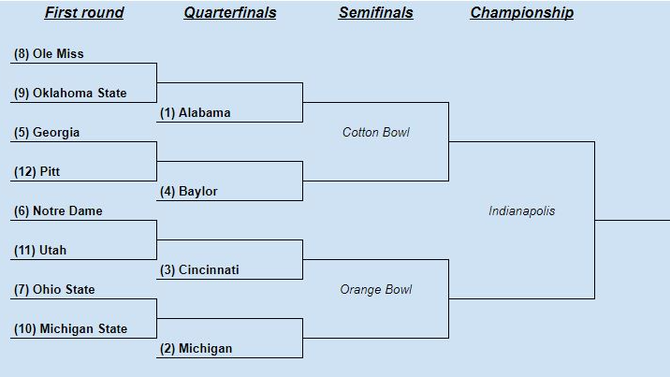
The 2021 College Football Playoff field is set, and the four teams were chosen without much controversy after most potential complications were sorted out on the field during Conference Championship Saturday. But if the playoff expands in the future, Selection Sundays are pretty much guaranteed to be filled with endless debate; more teams will mean more résumés to compare and contrast.
One proposal formulated by a playoff working group in June would expand the field to 12 teams with the top six conference champions receiving automatic bids. The other six teams would receive at-large bids.
Only time will tell if and when an expansion proposal is adopted and how closely it resembles the one publicized in June. The CFP Management Committee met last week and executive director Bill Hancock said there remains a “strong consensus that expansion is desirable.”
While the details still need to be ironed out, below is what a 12-team bracket would look like based on the June proposal. A few bullet points to remember first about that proposal:
- The top four conference champions would get byes, meaning even a team like this year’s Georgia squad that finished 12-1 would not be eligible for a bye since it lost in the SEC Championship Game.
- Teams ranked 5-8 would host teams ranked 9-12 in on-campus games in the first round.
- Quarterfinals would be played at bowl sites.
- The bracket would not take regular-season rematches into account when the teams are ranked, and there would not be reseeding in the quarterfinal or semifinal round.
Byes (Top-four conference champions)
1. Alabama
2. Michigan
3. Cincinnati
4. Baylor
Rest of field
5. Georgia
6. Notre Dame
7. Ohio State
8. Ole Miss
9. Oklahoma State
10. Michigan State
11. Utah (x)
12. Pitt (x)
x – conference champion
Matchup breakdown
No. 12 Pitt at No. 5 Georgia winner vs. No. 4. Baylor
No. 11 Utah at No. 6 Notre Dame winner vs. No. 3. Cincinnati
No. 10 Michigan State at No. 7 Ohio State winner vs. No. 2. Michigan
No. 9 Oklahoma State at No. 8 Ole Miss winner vs. 1. Alabama
This playoff bracket would feature some potential rematches of regular-season games and one guaranteed rematch with No. 10 Michigan State and No. 7 Ohio State squaring off again in a first-round game. Seeing the Buckeyes and Spartans play again at Ohio State after the Buckeyes thrashed the Spartans 56-7 on Nov. 20 would be a bit redundant. The winner of that rematch would get yet another rematch against Michigan in what amounts to a Big Ten playoff pod within the CFP.
Elsewhere, a Notre Dame victory over Utah in the first round would create a rematch between the Fighting Irish and Bearcats. Cincinnati won the first game at Notre Dame 24-13 but the rematch would be at a neutral site. This one would be pretty compelling, as it would feature last year’s Cincinnati defensive coordinator Marcus Freeman serving as Notre Dame’s head coach against the Bearcats and coach Luke Fickell, who was also in the running for the Notre Dame job after Brian Kelly’s departure for LSU.
Lastly, an Ole Miss win over Oklahoma State in the first round would give the Rebels another crack at Alabama after the Crimson Tide won a 42-21 game over the Rebels on Oct. 2. That game was the Rebels’ worst performance of the season, and seeing what they could do in the rematch would be reasonably compelling.
Of note, No. 13 BYU would be left out of this format despite beating Pac-12 champion Utah and having an overall better record than the Utes. In fact, the Cougars slipped a spot in the final CFP rankings. This was likely due to some finagling by the selection committee for New Year’s Six purposes, and of course there would be automatic bids to consider. However, there’s a bit of irony in the fact that there would be a greater gripe with this 12-team bracket than the four-team format currently in-place.


